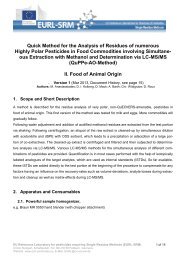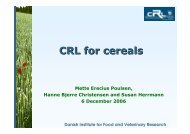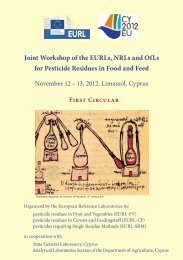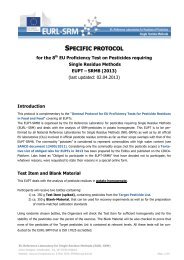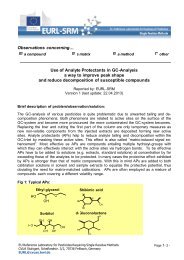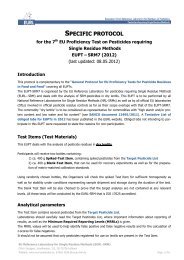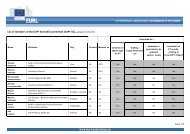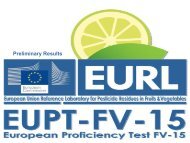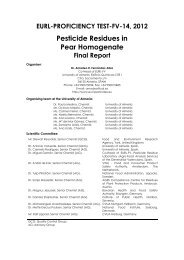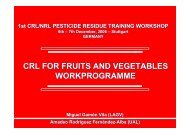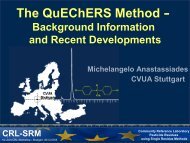Validation Report 9 - EURL | Residues of Pesticides
Validation Report 9 - EURL | Residues of Pesticides
Validation Report 9 - EURL | Residues of Pesticides
Create successful ePaper yourself
Turn your PDF publications into a flip-book with our unique Google optimized e-Paper software.
<strong>EURL</strong> for Cereals and Feeding stuff<br />
National Food Institute<br />
Technical University <strong>of</strong> Denmark<br />
<strong>Validation</strong> <strong>Report</strong> 9<br />
Screening <strong>of</strong> pesticide residues in cereals by UPLC-TOF<br />
(QuEChERS method)<br />
Hanne Bjerre Christensen &<br />
Mette Erecius Poulsen
29 March 2012
CONTENT:<br />
-3-<br />
1. Introduction ................................................................................................................................ 3<br />
2. Principle <strong>of</strong> analysis .................................................................................................................... 3<br />
3. <strong>Validation</strong> design ........................................................................................................................ 5<br />
4. Chromatograms .......................................................................................................................... 5<br />
5. Criteria for the acceptance <strong>of</strong> validation results .......................................................................... 6<br />
6. Results and discussion ................................................................................................................. 8<br />
7. Conclusions................................................................................................................................. 9<br />
9. References ................................................................................................................................. 10<br />
1. Introduction<br />
Qualitative multi residue methods, especially those involving automated MS-based detection, <strong>of</strong>fer<br />
laboratories a cost-effective means to extend their analytical scope to analytes which potentially<br />
have low probability to be present in the samples. The more commonly occurring analytes should<br />
continue to be sought and measured using quantitative MRMs.<br />
This report describes the screening validation <strong>of</strong> the QuEChERS method combined with UPLC-<br />
TOF MS. The method was validated for 35 pesticides in cereals at the screening detection limit,<br />
0.01 mg/kg.<br />
The QuEChERS method has an extraction and clean-up step, which has been developed to be<br />
Quick, Easy, Cheap, Efficient, Rugged and Safe. The method is most commonly used on fruit and<br />
vegetables 1 .<br />
The method validated here is based on the procedure for dry matrixes (
Screening:<br />
Different cereal samples were spiked at 0.01 mg/kg with a mix <strong>of</strong> pesticide standards ( Dr.<br />
Ehrenstorfer), extracted by and analysed by UPLC-QTOF (UPLC: Dionex RSLC; TOF: Bruker<br />
Daltronics, MaXis).<br />
LC conditions:<br />
-4-<br />
Column: Acclaim RSLC C18 2.2m 2.1x100mm (Dionex)<br />
Eluents: ESI(+): A: H2O/MeOH 90/10 (v/v), B: MeOH (both contain 5mM<br />
NH4formate, 0.01% HCOOH)<br />
Gradient and flowrate: see figure 1<br />
Injection volume: 1µl<br />
Runtime: 20 min<br />
Temperature: 30°C<br />
Figure 1: Figure and table <strong>of</strong> the multistep gradient used<br />
TOF conditions:<br />
Database:<br />
TOF instrument: Bruker Maxis QTOF (only operated as TOF)<br />
Ionisation mode: ESI positiv<br />
Calibration was performed externally prior to a sample series with a sodium formate<br />
solution, and additionally internally for each chromatogram by injecting the calibrant<br />
at the beginning <strong>of</strong> each run.<br />
Automated target detection for the pesticide standard mix spiked to cereal extracts can be achieved<br />
by automated peak detection on the EICs expected for the [M+H] + , [M+NH4] + or [M+Na] + ions <strong>of</strong><br />
each compound in a database. A database containing names, sum formulas, exact masses and<br />
National Food Institute, Technical University <strong>of</strong> Denmark
-5retention<br />
times for 100 pesticides was set up. Based on accurate mass and known retention times the<br />
compounds present in the sample are identified. For each identification candidate additionally the<br />
theoretical isotope abundance pattern is compared to the experimental obtained isotopic pattern.<br />
3. <strong>Validation</strong> design<br />
The method was sought validated for 38 pesticides in cereals. The validation was performed on 20<br />
replicates, and blank material was spiked at the expected screening reporting limit (SDL), which in<br />
this case was 0.01 mg/kg. The validation was performed on wheat, rye, oat, barley (5 replicates<br />
each).<br />
4. Chromatograms<br />
Examples <strong>of</strong> a chromatogram obtained when analysing the extracts by UPLC-TOF are presented in<br />
figure 2. The chromatogram show the base peak chromatogram (BPC) overlaid with extracted ion<br />
chromatograms (EIC) <strong>of</strong> the compounds detected from the database. Below the chromatogram all<br />
detected traces with accurate mass measurements are shown (the list was cut <strong>of</strong>f for fitting<br />
purposes).<br />
Figure 2: Chromatogram showing both base peak chromatogram overlaid with extracted ion chromatograms <strong>of</strong> the<br />
compounds detected from the database. The accurate mass <strong>of</strong> all the peaks detected.<br />
National Food Institute, Technical University <strong>of</strong> Denmark
Figure 3: Top: Extracted ion chromatogram <strong>of</strong> the selected peak<br />
Bottom: Measured isotope pattern from the selected peak<br />
Small box right upper corner: Theoretical isotope pattern (from molecular formula)<br />
-6-<br />
For each extracted ion chromatogram a peak can be isolated and the measured isotopic pattern can<br />
be investigated, as shown in figure 3. The measured isotopic pattern may be compared/matched to<br />
the theoretical isotopic pattern for the given pesticide. The match is measured and if the given<br />
criteria are fulfilled, the probability for the correct formula is high.<br />
5. Criteria for the acceptance <strong>of</strong> validation results<br />
Screening Detection limit, LDL<br />
The screening detection limit (SDL) <strong>of</strong> a qualitative screening method is the lowest concentration<br />
for which it has been demonstrated that a certain analyte can be detected in at least 95% <strong>of</strong> the<br />
samples (i.e. a false negative rate <strong>of</strong> 5% is accepted) 3 .<br />
Criteria for searching the database<br />
For identification the database set up for pesticides was used. The probability <strong>of</strong> correct<br />
identification depend on which criteria’s that are selected relating to the database search. Figure 4 is<br />
screen shot <strong>of</strong> the parameters selected for this validation. The mSigma value indicates a high<br />
probability <strong>of</strong> unequivocal identification. If the identification tolerance value is below 50 it<br />
indicates a high probability <strong>of</strong> correct formula. If the values from the screening report are above 50<br />
National Food Institute, Technical University <strong>of</strong> Denmark
-7and<br />
5mDa respectively, the inputs are checked manually. Retention time is required for the<br />
attribution <strong>of</strong> the individual isomers.<br />
Retention time tolerance: 0.5 min<br />
Identification tolerance: 10 mDa.<br />
mSigma threshold < 100<br />
Figure 4: Parameters for the detection with database<br />
Figure 5: List <strong>of</strong> detected compunds form the database listed according to the degree <strong>of</strong> identification<br />
When the s<strong>of</strong>tware has finish the database searching, a table with identified compounds is shown,<br />
see figure 5. The table includes how well the compounds matches the measured accurate mass,<br />
National Food Institute, Technical University <strong>of</strong> Denmark
-8retention<br />
time and isotopic pattern compared to the theoretical, and rates the degree <strong>of</strong> unequivocal<br />
identification <strong>of</strong> the compound.<br />
6. Results and discussion<br />
The 81 pesticides sought validated presented in table 1. Here<strong>of</strong> 35 pesticides were accepted for<br />
validation at 0.01 mg/kg, here the compounds were detected in at least 95% <strong>of</strong> the samples, see<br />
table 1.<br />
It was tested whether the criteria were set to strict, and if more pesticides would be accepted with<br />
less strict criteria. Changing the criteria as intensity and area threshold did not affect the<br />
identification, however setting the accurate mass and msigma value less strict allowed for a few<br />
additional pesticides to be validated.<br />
Table 1: Compounds sought validated for screening in cereals. The pesticides accepted are marked with pale green.<br />
Compounds No. detected % detected<br />
3-hydroxy carb<strong>of</strong>uran 12 60%<br />
Bensulfuron-methyl 17 85%<br />
Bromacil 1 5%<br />
Butralin 7 35%<br />
Buturon 20 100%<br />
Carbaryl 5 25%<br />
Carbendazim 20 100%<br />
Chlorbromuron 17 85%<br />
Chlorotoluron 19 95%<br />
Chlorsulfuron 7 35%<br />
Chromafenozide 1 5%<br />
Crufomate 20 100%<br />
Cyanazine 1 5%<br />
Cyprazin 19 95%<br />
DEET (diethyltoluamide) 19 95%<br />
Desmetryn 20 100%<br />
Difenoxuron 20 100%<br />
Diflubenzuron 9 45%<br />
Dimefuron 20 100%<br />
Dimethachlor 9 45%<br />
Dinotefuran 7 35%<br />
Dioxacarb 5 25%<br />
Esprocarb 18 90%<br />
Ethoprop (Ethoprophos) 20 100%<br />
Et<strong>of</strong>enprox 13 65%<br />
Fenhexamid 11 55%<br />
Fenothiocarb 17 85%<br />
Flonicamid 20 100%<br />
Flumetsulam 19 95%<br />
Fluometuron 20 100%<br />
Forchlorfenuron 11 55%<br />
Formetanate 1 5%<br />
Furalaxyl 19 95%<br />
Furathiocarb 20 100%<br />
Imazalil 20 100%<br />
Imazamox 13 65%<br />
Imazapyr 9 45%<br />
Imazaquin 17 85%<br />
Imidacloprid 9 45%<br />
National Food Institute, Technical University <strong>of</strong> Denmark
Isopropalin 2 10%<br />
Isoproturon 17 85%<br />
Isoxathion 19 95%<br />
Linuron 17 85%<br />
Malaoxon 20 100%<br />
Mefenacet 19 95%<br />
Mepronil 18 90%<br />
Metacriphos 1 5%<br />
Metamitron 19 95%<br />
Methoprene 11 55%<br />
Metolachlor 18 90%<br />
Metosulam 3 15%<br />
Monuron TCA 19 95%<br />
Neburon 19 95%<br />
Nitenpyram 13 65%<br />
Novaluron 3 15%<br />
Orbencarb 12 60%<br />
Oxadiargyl 8 40%<br />
Oxadiazon 11 55%<br />
Oxydemeton-methyl 20 100%<br />
Paraoxon-methyl 20 100%<br />
Pr<strong>of</strong>oxydim 14 70%<br />
Prometon 19 95%<br />
Propazine 20 100%<br />
Pyraclostrobin 17 85%<br />
Pyributicarb 20 100%<br />
Pyrimidifen 14 70%<br />
Quinoxyfen 20 100%<br />
Sebuthylazine 20 100%<br />
Simetryn 20 100%<br />
Spiroxamine 20 100%<br />
Tebuthiuron 20 100%<br />
Terbumeton 20 100%<br />
Thiacloprid 18 90%<br />
Thidiazuron 9 45%<br />
Thiobencarb 14 70%<br />
Thiodicarb 2 10%<br />
Thiophanate-methyl 13 65%<br />
Tricyclazole 20 100%<br />
Trifloxysulfuron 19 95%<br />
Triflumizole 3 15%<br />
Warfarin 10 50%<br />
7. Conclusions<br />
-9-<br />
Only 35 compounds were validated at the expected screening detection limit at the criteria set for<br />
the database identification. It should be noted that the expected screening detection limit at 0.01<br />
mg/kg may be too low for cereals, and should be 0.02 mg/kg instead. For future validation both<br />
levels should be tested. Similar validation was performed on fruit and vegetables, with spiking at<br />
SDL (0.01 mg/kg), here many more compounds were validated. This indicates that it should be<br />
taken into consideration if the SDL for cereals should be 0.02mg/kg.<br />
For routine analysis non detects should be reported as
8. References<br />
1 http://www.quechers.com/<br />
-10-<br />
2 The Composition <strong>of</strong> Foods – fourth edition by Erling Saxholt, Gyldendals, 1996.<br />
3 Method <strong>Validation</strong> and Quality Control Procedures for Pesticide Residue Analysis in Food and<br />
Feed, Document N° SANCO/12495/2011, European Commission, Brussels, 2012.<br />
National Food Institute, Technical University <strong>of</strong> Denmark



